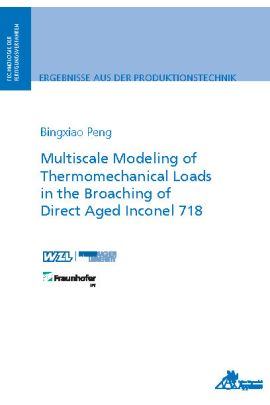Dieses E-Book können Sie hier herunterladen.
The broaching process remains an essential machining process due to its reliability and economic benefits in the manufacturing of fir tree slots in turbine disks for aircraft engines. The cost- and time-intensive experiment-based approach restricts the application of alternative cutting tool materials when broaching nickel-based alloys. In order to accelerate the development process, the broaching process should be modeled and predicted.
The goal of this thesis is therefore to investigate a model-based multiscale approach to predict the thermomechanical loads and the resulting tool wear when broaching nickel-based alloys.
In the inductive step, thermomechanical loads were investigated experimentally and numerically in orthogonal cutting of DA718 with carbide cutting tools. The empirical investigation focused on exploring cutting mechanisms in terms of cutting force components, chip forms, tool wear developments and cutting temperatures. The empirical investigation contributed to the development of a 2D FEM chip formation model based on the CEL formulation. With the calibrated material and friction model, the FE model was validated with respect to the cutting force and the chip form. The prediction of the cutting normal force was significantly improved by the incorporation of the tool wear into the FE model.
In the deductive step, predictive models based on data-driven methods including artificial neural networks and random forests were investigated to represent the specific cutting force components, cutting temperatures, and tool wear development as a function of the process parameters in orthogonal cutting. Furthermore, a novel hybrid approach was proposed to predict tool wear development, combining the advantages of FEM chip formation simulations, ML algorithms, and empirical-analytical tool wear models. These predictive models were used as the universal interfaces to enable the multiscale approach. In the second part of the deductive step, the broaching process was modeled at the macroscopic level. This approach calculated thermomechanical loads as a function of the local cutting conditions along the discretized cutting edge. The tool wear development and cutting force components were then derived and validated for broaching processes. Given the accuracy and the computation time, the multiscale modeling approach presents great advantages in prediction of the broaching process.
| Autor | Peng, Bingxiao |
|---|---|
| Lieferzeit | 3-4 Tage |
| Gewicht | 0.279 kg |
| Erscheinungsdatum | 18.01.2021 |
Technologie der Fertigungsverfahren
Multiscale Modeling of Thermomechanical Loads in the Broaching of Direct Aged Inconel 718 (E-Book)
Kurzbeschreibung
Dieses E-Book können Sie hier herunterladen.
The broaching process remains an essential machining process when manufacturing fir tree slots in turbine disks for aircraft engines. The cost- and time-intensive experiment-based approach restricts the application of alternative cutting tool materials when broaching nickel-based alloys. Given the accuracy and computation time, the developed model-based multiscale approach presents great advantages in prediction of the broaching process and thus can accelerate the development process.

